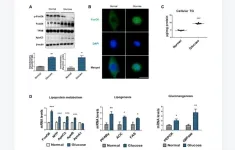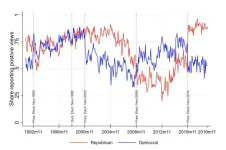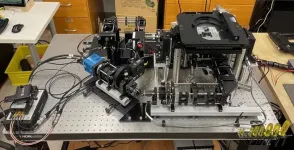(Press-News.org)
The turbulent motion of a tumbling river or the outflow from a jet engine is chaotic: that is, it contains no obvious pattern.
But according to a new study, regular patterns can emerge from the turbulent motion of fluids. What you need is an intriguing property called “odd viscosity” that arises under certain conditions, such as when the particles in the fluid all spin in the same direction. Though it’s a specialized circumstance, there are many contexts in nature where a version of this effect may exist, such as in the corona of the sun and the solar wind.
“This surprising effect may add to the growing toolbox to control and shape turbulence,” said Michel Fruchart, formerly a postdoctoral researcher at UChicago, now faculty at the French Centre National de la Recherche Scientifique (CNRS) and co-first author of the paper describing the findings.
The study, a collaboration between the University of Chicago, Eindhoven University of Technology in the Netherlands, and CNRS, is published March 20 in Nature.
A chaotic nature
Despite how much we’ve learned about classical physics in the past centuries, there’s one problem that still resists full explanation: the phenomenon known as turbulence. Though turbulence appears every day around us—from the clouds churning in the atmosphere overhead to the very blood flowing through our vessels—it is still not as well understood as other common physical phenomena.
“Turbulence might be commonplace in nature, but it is still only partially understood,” said Xander de Wit, co-first author of the publication and a Ph.D student with Eindhoven University of Technology.
This is despite the fact that if we could understand and control turbulence, we might be able to achieve many breakthroughs; perhaps we could design more efficient airplane wings, engines, and wind turbines, for example.
However, there are things scientists do know about turbulence. If you shake a bottle of water, you’ll see eddies forming. They start out at roughly the size of the length of the bottle; then the eddies split into smaller eddies, and then again into smaller eddies, and so on until the eddies dissipate. This is known as a cascade. But if you do the same thing but confine the water to a thin layer, the eddies will instead merge to form one big vortex—the Great Red Spot on Jupiter’s surface is an example of this phenomenon, said Fruchart.
The group of scientists wondered if it was possible to make, and hold, medium-size eddies—neither one big eddy, nor smaller and smaller ones.
The answer is yes—if your fluid has is displaying a property known by the term “odd viscosity.”
Viscosity usually means a measurement of how hard it is to stir—for example, it’s harder to stir a jar of honey versus a jar of water. In normal viscosity, the movement dissipates the energy you’ve injected to it by stirring with your spoon. But “odd viscosity” changes the way objects move but doesn’t dissipate energy. It’s been seen in certain rare conditions in the laboratory.
The researchers built a simulation where the particles displayed ‘odd viscosity,’—in this case, by making all of the particles of the fluid spin like tops. Then, by tweaking the parameters, such as how fast the particles spin, the researchers found a surprise. At a particular point, they began to see patterns instead of random eddies.
“The trick, we found, is to create a mixed cascade, where large eddies tend to split and small eddies tend to merge,” said Fruchart. “If you get the balance just right, you see patterns form.”
“When we first saw these effects, we didn’t fully understand what we were looking at, but you could tell there was something different even to the unaided eye,” said study co-author and UChicago Ph.D student Tali Khain. “We had to develop a theory to explain it, and that was really exciting.”
Though not all particles in fluids spin like tops, there are examples in nature. For example, electrons or polyatomic gases in a magnetic field do behave this way.
“In addition to the sun and solar wind, there are diverse contexts where a version of this effect may exist, including atmospheric flows, plasmas and active matter,” said UChicago Prof. Vincenzo Vitelli, one of the senior authors on the paper.
As the scientists work to develop a fuller understanding of their findings, they hope it will lead to a better understanding of the interplay between eddies and waves in turbulent flows.
“We are only at the beginning,” Vitelli said, “but I am fascinated by the idea that you can take a turbulent state that is the epitome of chaos, and use it to make patterns—that is a profound change made by just a twist on the smallest scale.”
END
COLUMBUS, Ohio — Treating anxiety and depression significantly reduced emergency room visits and rehospitalizations among people with heart disease, according to a study by researchers at The Ohio State University Wexner Medical Center.
“For patients hospitalized for coronary artery disease or heart failure and who had diagnoses of anxiety or depression, treatment with psychotherapy, medication or both was associated with as much as a 75% reduction in hospitalizations or emergency room visits. In some cases, there was a reduction in death,” said lead study author Philip Binkley, MD, executive ...
A study led by University of Oklahoma researchers has been selected for a 2023 best paper award in the Advanced Formation Evaluation technical program theme from the Unconventional Resources Technology Conference.
The study examined how clay and kerogen, two different components within rocks, respond to nuclear magnetic resonance, or NMR, a technique used to assess the amount of fluids within rocks. Many fluids found within rocks contain hydrogen, and knowing whether and how much hydrogen is available in the subsurface is an important facet of oil and gas exploration. Researchers found that higher NMR frequencies improved data acquisition efficiency.
As a result of this study, a ...
“This discovery unveils a potential novel molecular target for therapeutic strategies against hepatic steatosis during the aging process [...]”
BUFFALO, NY- March 20, 2024 – A new research paper was published in Aging (listed by MEDLINE/PubMed as "Aging (Albany NY)" and "Aging-US" by Web of Science) Volume 16, Issue 5, entitled, “FoxO6-mediated ApoC3 upregulation promotes hepatic steatosis and hyperlipidemia in aged rats fed a high-fat diet.”
FoxO6, an identified factor, induces hyperlipidemia and hepatic steatosis during aging by activating hepatic ...
Dr. Cochav Elkayam-Levy, of the Hebrew University of Jerusalem awarded the Israel Prize in the field of Solidarity (Arvut Hadadit) for her tireless work to raise awareness and acknowledgement to the crimes committed by Hamas on and following October 7th against Israeli women, children, men and families. Elkayam-Levy established the “Civil Commission on October 7th Crimes by Hamas against Women and Children”, aimed at giving voice to the victims and their families and raising awareness of the concerning developments in war crimes against women, children, men and families on and after October 7th and raising support for this cause.
Dr. Cochav Elkayam-Levy: ...
A new study from the University of Florida's Bureau of Economic and Business Research (BEBR) has found that national elections have a greater impact on consumer sentiment and spending intentions than previously thought, especially during transitions of power between political parties. Led by Hector Sandoval, director of the Economic Analysis Program and research assistant professor at BEBR, the study draws on years of meticulous observation and analysis of monthly sentiments data collected by the UF Survey Research Center.
Despite the wealth of data available ...
Artificial intelligence can spot COVID-19 in lung ultrasound images much like facial recognition software can spot a face in a crowd, new research shows.
The findings boost AI-driven medical diagnostics and bring health care professionals closer to being able to quickly diagnose patients with COVID-19 and other pulmonary diseases with algorithms that comb through ultrasound images to identify signs of disease.
The findings, newly published in Communications Medicine, culminate an effort that started early in the pandemic when clinicians needed tools to rapidly assess legions of patients in overwhelmed emergency rooms.
“We developed ...
EMBARGOED FOR RELEASE UNTIL 4 P.M. ET, WEDNESDAY, MARCH 20, 2024
MINNEAPOLIS – People who have an influenza infection are more likely to need medical care for neurologic disorders within the next year than people who have a COVID-19 infection, according to a study published in the March 20, 2024, online issue of Neurology®, the medical journal of the American Academy of Neurology. The study, funded by the American Academy of Neurology, looked at people who were hospitalized with either influenza or COVID-19. The study did not look specifically at outcomes ...
The first generation of stars transformed the universe. Inside their cores, simple hydrogen and helium fused into a rainbow of elements. When these stars died, they exploded and sent these new elements across the universe. The iron running in your veins and the calcium in your teeth and the sodium powering your thoughts were all born in the heart of a long-dead star.
No one has been able to find one of those first generation of stars, but scientists have announced a unique finding: a star from the second generation that originally formed in a different galaxy from ours.
“This ...
Researchers have incorporated a swept illumination source into an open-top light-sheet microscope to enable improved optical sectioning over a larger area of view. The advance makes the technique more practical for nondestructive 3D pathology.
3D pathology is being explored as an alternative to traditional slide-based histology because it can provide detailed 3D insights into pathological structures and cellular interactions without altering the tissue. This approach makes it possible to analyze complex 3D tissue structures and to image thick tissues, which is not possible with slide-based methods.
The researchers used their improved open-top ...
In a new Nature study, Columbia Engineering researchers have built a photonic chip that is able to produce high-quality, ultra-low-noise microwave signals using only a single laser. The compact device — a chip so small, it could fit on a sharp pencil point — results in the lowest microwave noise ever observed in an integrated photonics platform.
The achievement provides a promising pathway towards small-footprint ultra-low-noise microwave generation for applications such as high-speed communication, atomic clocks, and autonomous vehicles.
The challenge
Electronic devices for global navigation, wireless communications, radar, and ...





